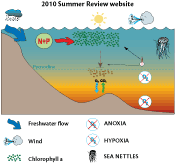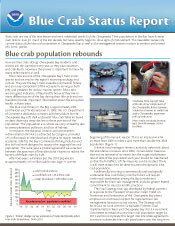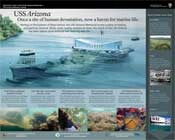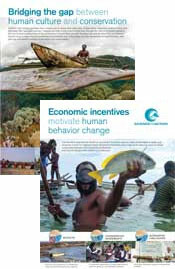2010 Chesapeake Bay summer conditions better than average
 Summer conditions for 2010 were influenced by above-average winter river flow and below-average late spring and summer flow into the Bay. The timing of flow was important this year, in comparison to 2009, when the spatial pattern of flow into the Bay was important. Additionally, summer air temperatures in 2010 were above average, and combined with flow, can affect phytoplankton and fish in the Bay. 2010 summer conditions included below-average fish kills, less abundant sea nettles, and a smaller volume of low dissolved oxygen.
Summer conditions for 2010 were influenced by above-average winter river flow and below-average late spring and summer flow into the Bay. The timing of flow was important this year, in comparison to 2009, when the spatial pattern of flow into the Bay was important. Additionally, summer air temperatures in 2010 were above average, and combined with flow, can affect phytoplankton and fish in the Bay. 2010 summer conditions included below-average fish kills, less abundant sea nettles, and a smaller volume of low dissolved oxygen.
Blue Crab Status Report
 Blue crabs are one of the best-known and most celebrated symbols of the Chesapeake. Their populations in the Bay have hovered near historic lows for much of the last decade, but have recently begun to show signs of improvement. This newsletter reviews the current status of the blue crab population in the Chesapeake Bay as well as the management systems in place to monitor and protect this iconic species.
Blue crabs are one of the best-known and most celebrated symbols of the Chesapeake. Their populations in the Bay have hovered near historic lows for much of the last decade, but have recently begun to show signs of improvement. This newsletter reviews the current status of the blue crab population in the Chesapeake Bay as well as the management systems in place to monitor and protect this iconic species.
USS Arizona: once a site of human devastation, now a haven for marine life.
 Tim Carruthers and Jane Hawkey spent a few days this past June with the National Park Service staff of the USS Arizona Memorial on Oahu, Hawaii, to create this poster. Designed for both the general public and school audiences, it provides a unique perspective on the historic WWII ship—one of a bounty of marine life that have made the sunken wreck their home. Modern environmental challenges face Pearl Harbor, the lagoon where the USS Arizona rests, such as sedimentation, pollution, and invasive species.
Tim Carruthers and Jane Hawkey spent a few days this past June with the National Park Service staff of the USS Arizona Memorial on Oahu, Hawaii, to create this poster. Designed for both the general public and school audiences, it provides a unique perspective on the historic WWII ship—one of a bounty of marine life that have made the sunken wreck their home. Modern environmental challenges face Pearl Harbor, the lagoon where the USS Arizona rests, such as sedimentation, pollution, and invasive species.
Conservation International policy briefs released
 Two new policy briefs, resulting from a collaboration between IAN staff and Conservation International's Science to Action program, have just been released. "Economic Incentives Motivate Human Human Behavior Change" features the three approaches to providing economic incentives to conserve natural resources. Tips for designing a successful incentive program are described. "Bridging the Gap Between Human Culture and Conservation" examines the relationship between coastal communities and the marine resources they depend on, both in the culture, economies, and lifestyles of the people. Four countries with marine managed areas are highlighted.
Two new policy briefs, resulting from a collaboration between IAN staff and Conservation International's Science to Action program, have just been released. "Economic Incentives Motivate Human Human Behavior Change" features the three approaches to providing economic incentives to conserve natural resources. Tips for designing a successful incentive program are described. "Bridging the Gap Between Human Culture and Conservation" examines the relationship between coastal communities and the marine resources they depend on, both in the culture, economies, and lifestyles of the people. Four countries with marine managed areas are highlighted.